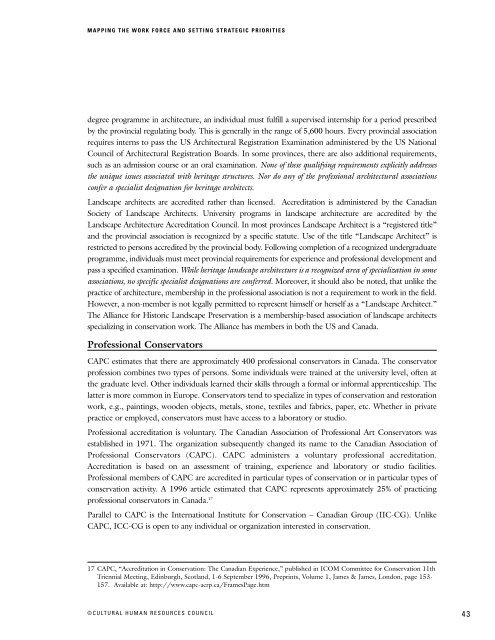Human Resources in Canada's Built Heritage Sector: Mapping the ...
Human Resources in Canada's Built Heritage Sector: Mapping the ...
Human Resources in Canada's Built Heritage Sector: Mapping the ...
- No tags were found...
Create successful ePaper yourself
Turn your PDF publications into a flip-book with our unique Google optimized e-Paper software.
MAPPING THE WORK FORCE AND SETTING STRATEGIC PRIORITIESdegree programme <strong>in</strong> architecture, an <strong>in</strong>dividual must fulfill a supervised <strong>in</strong>ternship for a period prescribedby <strong>the</strong> prov<strong>in</strong>cial regulat<strong>in</strong>g body. This is generally <strong>in</strong> <strong>the</strong> range of 5,600 hours. Every prov<strong>in</strong>cial associationrequires <strong>in</strong>terns to pass <strong>the</strong> US Architectural Registration Exam<strong>in</strong>ation adm<strong>in</strong>istered by <strong>the</strong> US NationalCouncil of Architectural Registration Boards. In some prov<strong>in</strong>ces, <strong>the</strong>re are also additional requirements,such as an admission course or an oral exam<strong>in</strong>ation. None of <strong>the</strong>se qualify<strong>in</strong>g requirements explicitly addresses<strong>the</strong> unique issues associated with heritage structures. Nor do any of <strong>the</strong> professional architectural associationsconfer a specialist designation for heritage architects.Landscape architects are accredited ra<strong>the</strong>r than licensed. Accreditation is adm<strong>in</strong>istered by <strong>the</strong> CanadianSociety of Landscape Architects. University programs <strong>in</strong> landscape architecture are accredited by <strong>the</strong>Landscape Architecture Accreditation Council. In most prov<strong>in</strong>ces Landscape Architect is a “registered title”and <strong>the</strong> prov<strong>in</strong>cial association is recognized by a specific statute. Use of <strong>the</strong> title “Landscape Architect” isrestricted to persons accredited by <strong>the</strong> prov<strong>in</strong>cial body. Follow<strong>in</strong>g completion of a recognized undergraduateprogramme, <strong>in</strong>dividuals must meet prov<strong>in</strong>cial requirements for experience and professional development andpass a specified exam<strong>in</strong>ation. While heritage landscape architecture is a recognized area of specialization <strong>in</strong> someassociations, no specific specialist designations are conferred. Moreover, it should also be noted, that unlike <strong>the</strong>practice of architecture, membership <strong>in</strong> <strong>the</strong> professional association is not a requirement to work <strong>in</strong> <strong>the</strong> field.However, a non-member is not legally permitted to represent himself or herself as a “Landscape Architect.”The Alliance for Historic Landscape Preservation is a membership-based association of landscape architectsspecializ<strong>in</strong>g <strong>in</strong> conservation work. The Alliance has members <strong>in</strong> both <strong>the</strong> US and Canada.Professional ConservatorsCAPC estimates that <strong>the</strong>re are approximately 400 professional conservators <strong>in</strong> Canada. The conservatorprofession comb<strong>in</strong>es two types of persons. Some <strong>in</strong>dividuals were tra<strong>in</strong>ed at <strong>the</strong> university level, often at<strong>the</strong> graduate level. O<strong>the</strong>r <strong>in</strong>dividuals learned <strong>the</strong>ir skills through a formal or <strong>in</strong>formal apprenticeship. Thelatter is more common <strong>in</strong> Europe. Conservators tend to specialize <strong>in</strong> types of conservation and restorationwork, e.g., pa<strong>in</strong>t<strong>in</strong>gs, wooden objects, metals, stone, textiles and fabrics, paper, etc. Whe<strong>the</strong>r <strong>in</strong> privatepractice or employed, conservators must have access to a laboratory or studio.Professional accreditation is voluntary. The Canadian Association of Professional Art Conservators wasestablished <strong>in</strong> 1971. The organization subsequently changed its name to <strong>the</strong> Canadian Association ofProfessional Conservators (CAPC). CAPC adm<strong>in</strong>isters a voluntary professional accreditation.Accreditation is based on an assessment of tra<strong>in</strong><strong>in</strong>g, experience and laboratory or studio facilities.Professional members of CAPC are accredited <strong>in</strong> particular types of conservation or <strong>in</strong> particular types ofconservation activity. A 1996 article estimated that CAPC represents approximately 25% of practic<strong>in</strong>gprofessional conservators <strong>in</strong> Canada. 17Parallel to CAPC is <strong>the</strong> International Institute for Conservation – Canadian Group (IIC-CG). UnlikeCAPC, ICC-CG is open to any <strong>in</strong>dividual or organization <strong>in</strong>terested <strong>in</strong> conservation.17 CAPC, “Accreditation <strong>in</strong> Conservation: The Canadian Experience,” published <strong>in</strong> ICOM Committee for Conservation 11thTriennial Meet<strong>in</strong>g, Ed<strong>in</strong>burgh, Scotland, 1-6 September 1996, Prepr<strong>in</strong>ts, Volume 1, James & James, London, page 153-157. Available at: http://www.capc-acrp.ca/FramesPage.htm©CULTURAL HUMAN RESOURCES COUNCIL43










